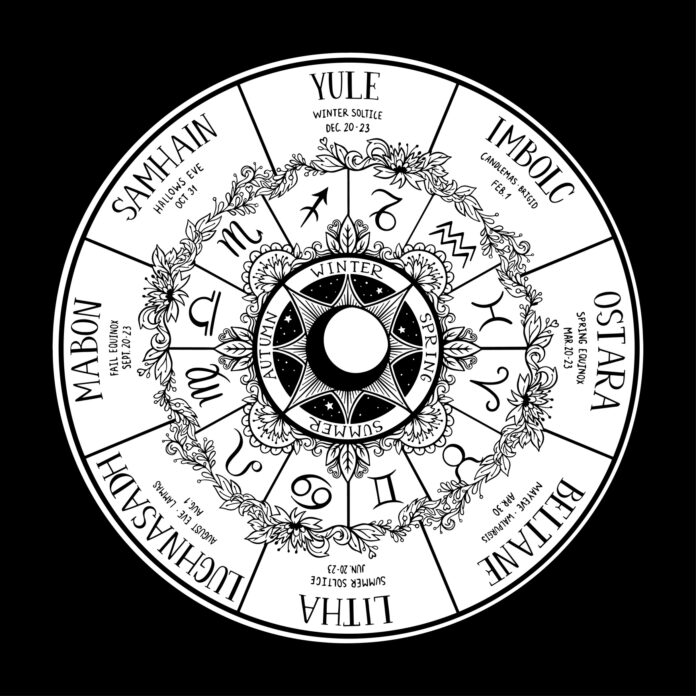The Witches’ Sabbats, also known as the Wheel of the Year, are a series of eight festivals celebrated in various modern pagan and witchcraft traditions. These festivals mark key points in the solar calendar, representing the changing seasons and the cycles of nature.
The aim of this post is to give you a simple overview of the Sabbats. I will go into more detail about each sabbat and how to celebrate them in future posts, starting with Yule.
The Sabbats are divided into two categories: the Greater Sabbats, also known as the cross-quarter days, and the Lesser Sabbats, which coincide with the solstices and equinoxes. The Greater Sabbats often involve more seasonal and thematic celebrations, while the Lesser Sabbats are associated with the astronomical shifts that occur during the solstices and equinoxes. Together, they form the cyclical and nature-based rhythm of the Wheel of the Year.
Greater Sabbats (Cross-Quarter Days)
The four Greater Sabbat festivals fall roughly midway between the solstices and equinoxes, dividing the solar year into four equal parts. The Greater Sabbats are Samhain, Imbolc, Beltane, and Lammas/Lughnasadh. These festivals are often associated with the changing seasons and the agricultural cycle, such as the shift from winter to spring or summer to autumn.
Lesser Sabbats (Solstices and Equinoxes)
The four Lesser Sabbat festivals coincide with the solstices and equinoxes. The solstices and equinoxes are key astronomical events marking distinct points in Earth’s orbit around the sun. The Lesser Sabbats are Yule, Ostara, Litha, and Mabon.
Yule, or the winter solstice, is celebrated around December 21st when the sun is at its lowest point in the sky and the day is the shortest. Litha, or the Summer Solstice, is celebrated around June 21st and is the point when the sun is highest in the sky and the day is the longest
Ostara, or the spring equinox, is celebrated around March 21st and Mabon, or the autumn equinox, is celebrated around September 21st. The equinoxes signify the times when day and night are approximately equal in duration.
These celestial occurrences hold cultural, spiritual and agricultural significance across various civilizations, often serving as milestones for the changing seasons and inspiring a variety of cultural celebrations and rituals.
An introduction to the eight witches’ Sabbats
The following is a brief overview of the witches’ sabbats, what they signify and how they can be celebrated. Witches usually begin their year at Samhain. There are many ways to celebrate the Sabbats, from elaborate rituals and decorated altars to simply noticing the changing energies and seasons. You can celebrate the sabbats in any way that feels meaningful for you.
Samhain
Celebrated around October 31st in the Northern Hemisphere (April 30th in the Southern Hemisphere), Samhain marks the end of the harvest season and the beginning of winter. It is a time when the veil between the physical and spiritual realms is believed to be thin, making it a suitable time for honouring ancestors and divination.
Yule
Celebrated around December 21st in the Northern Hemisphere (June 21st in the Southern Hemisphere), Yule corresponds with the winter solstice. It marks the longest night and the return of the sun. Yule is a time for celebrating the rebirth of the sun and the lengthening of days. As with many traditions at this time of year, we light candles to welcome the sun’s return.
Imbolc
Celebrated around February 1st-2nd in the Northern Hemisphere (August 1st-2nd in the Southern Hemisphere), Imbolc marks the halfway point between the winter solstice and the spring equinox. It is associated with the first signs of spring and the Celtic goddess Brigid. Many witches like to decorate a seasonal altar and add spring flowers such as snowdrops.
Ostara
Celebrated around March 21st in the Northern Hemisphere (September 21st in the Southern Hemisphere), Ostara corresponds with the spring equinox. It is a time for celebrating the balance of day and night and the awakening of nature.
Beltane
Celebrated around May 1st in the Northern Hemisphere (November 1st in the Southern Hemisphere), Beltane marks the beginning of the warmer season. It is associated with fertility, love and the Maypole dance.
Litha/Midsummer
Celebrated around June 21st in the Northern Hemisphere (December 21st in the Southern Hemisphere), Litha corresponds with the summer solstice. It marks the longest day and the peak of the sun’s power.
Lammas/Lughnasadh
Celebrated around August 1st in the Northern Hemisphere (February 1st in the Southern Hemisphere), Lammas/Lughnasadh marks the first harvest. It is associated with the Celtic god Lugh and the reaping of grains.
Mabon
Celebrated around September 21st in the Northern Hemisphere (March 21st in the Southern Hemisphere), Mabon corresponds with the autumn equinox. It is a time for giving thanks for the harvest and preparing for the darker half of the year.
These Sabbats represent a cyclical and seasonal approach to spirituality, emphasizing the interconnectedness of nature and the changing energies throughout the year. Different traditions may have variations in the way these celebrations are observed.
I’ll be creating posts that go into more depth about each of the sabbats over the next year, starting with one on Yule in the next week or two. So don’t forget to check back, or sign up for my newsletter for updates.
